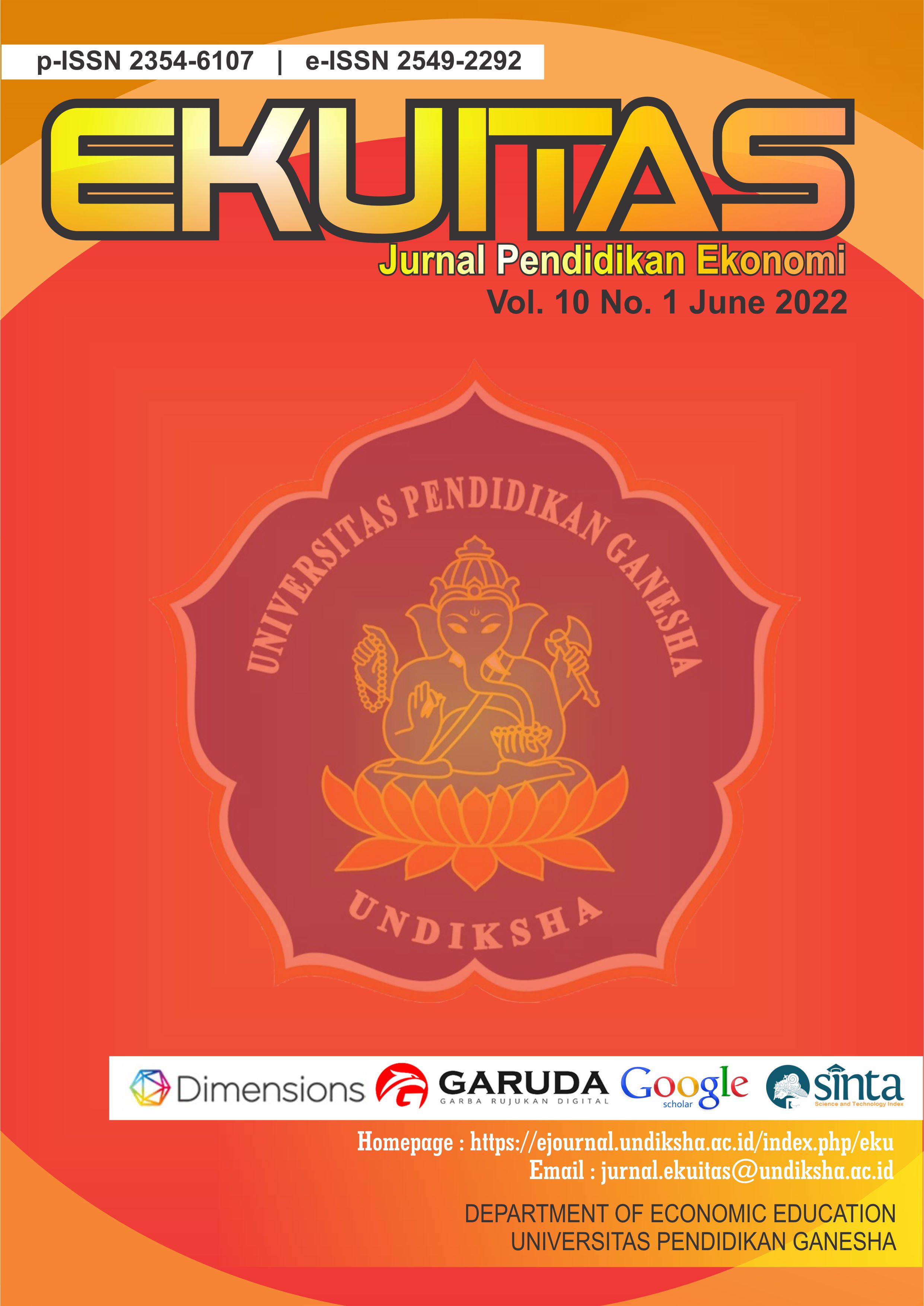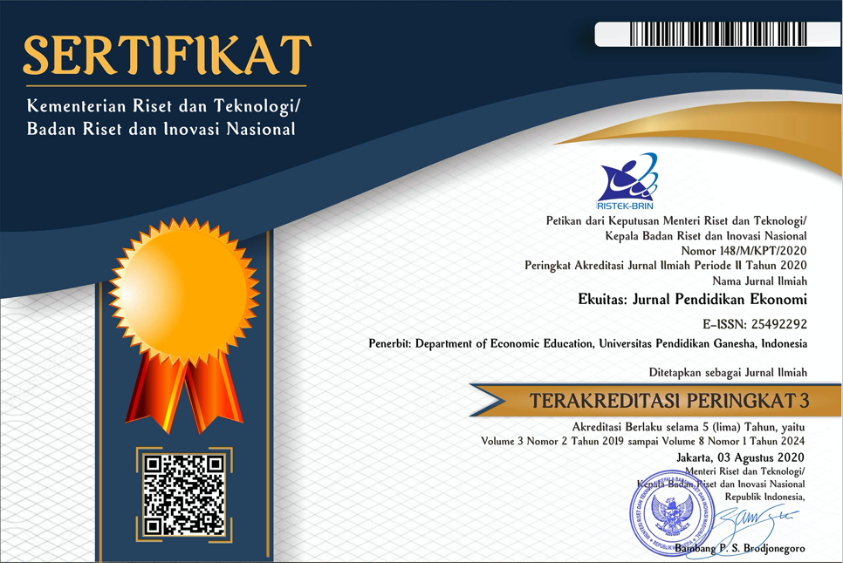Kajian Strategi Pemasaran Destinasi Wisata Warisan Budaya Dunia (WBD) Pura Tirta Empul Tampaksiring Gianyar
DOI:
https://doi.org/10.23887/ekuitas.v10i1.47855Keywords:
Marketing strategy, pura tirta empul, tourist destinationsAbstract
The fluctuating number of tourist visits tends to decrease from 2020 to 2022. Studying the marketing strategy carried out by the world cultural heritage (WBD) manager of Tirta Empul Temple in Tampaksiring, Gianyar, is fascinating. This study aims to examine the marketing strategy model commonly used to determine the most significant factors influencing tourist visits to these tourist objects, which are leading tourist destinations. This study was designed with a descriptive and analytic approach, namely reviewing and analyzing the marketing strategy model used, then integrated with the results of the policy analysis of the Gianyar Regency Government in developing a marketing strategy for the WBD Pura Tirta Empul Tampaksiring tourist attraction to provide services to tourists. The study and research of the developed model for promotion found that e-commerce is the most potent factor, followed by word of mouth, publications, and advertising. For destination attributes, the most powerful factor influencing tourists to visit is the product of memories, location, available accommodation, ticket prices, and tourist attractions. At the same time, a fun, clean, safe, calm, new places, and a comfortable environment dominated by Place Branding. The most significant factor driving the decision to visit tourists is post-visit evaluation; this cannot be separated from the satisfaction felt after a previous visit. There are still differences in understanding in implementing the rules between the management, namely the Gianyar Regional Government as the first party and Pekraman Village as the second party, which can affect the quality of service and the level of tourist visits.
References
Almeyda-Ibáñez, M., & George, B. P. (2017). The evolution of destination branding: A review of branding literature in tourism. Journal of Tourism, Heritage & Services Marketing (JTHSM), 3(1), 9–17.
Aprilia, F. (2015). Pengaruh Word Of Mouth Terhadap Minat Berkunjung Serta Dampaknya Pada Keputusan Berkunjung (Survei pada Pengunjung Tempat Wisata “Jawa Timur Park 2” Kota Batu). Brawijaya University.
Auliandri, T. A. (2017). Analisa Aktivitas Manajemen Strategi pada Industri Pariwisata Berbasis Digital. INOBIS: Jurnal Inovasi Bisnis Dan Manajemen Indonesia, 1(1), 10–17.
Bennett, P. D., & Association, A. M. (1995). Dictionary of marketing terms.
Dahiya, K. S., & Batra, D. K. (2016). Tourist decision making: Exploring the destination choice criteria. Asian Journal of Management Research, 7(2), 140–153.
Denzin, N. K., & Lincoln, Y. S. (2011). The Sage handbook of qualitative research. sage.
Hawkins, D. I., Best, R. J., & Coney, K. A. (1998). Consumer behavior: building market strategy. McGraw-Hill.
Marshall, C., & Rossman, G. B. (2014). Designing qualitative research. Sage publications.
Moleong, L. J. (2021). Metodologi penelitian kualitatif. PT Remaja Rosdakarya.
Napitupulu, N. U. (2015). Strategi pemasaran pariwisata budaya mentawai melalui produk kesenian muturuk. Jurnal Desain Dan Seni, 2(1), 59–66.
Nuryanti, W. (1995). Perencanaan Pembangunan Regional dan Kawasan untuk Kepariwisataan Alam. Di Dalam: Chafid Fandeli, Editor. Dasar-Dasar Manajemen Kepariwisataan Alam. Liberty. Yogyakarta.
Pasha, M. F., & Munawaroh, R. R. S. (2021). Peran Promosi Dalam Meningkatkan Kunjungan Wisatawan Rumah Anno 1925 di Siring Tendean Banjarmasin. Jurnal Manajemen Dan Akuntansi, 22(1).
Payne, A., & Tjiptono, F. (1993). Pemasaran jasa: The essence of services marketing.
Pearce II, J. A., & Robbins, D. K. (2008). Strategic transformation as the essential last step in the process of business turnaround. Business Horizons, 51(2), 121–130.
Pujiastuti, E. E., Nimran, U., Suharyono, S., & Kusumawati, A. (2017). The antecedents of behavioral intention regarding rural tourism destination. Asia Pacific Journal of Tourism Research, 22(11), 1169–1181.
Setiyorini, A., Farida, U., & Kristiyana, N. (2018). Pengaruh Promosi Melalui Media Sosial, Word of Mouth, Dan Daya Tarik Wista Terhadap Keputusan Berkunjung Wisatawan Obyek Wisata Gunung Beruk Karangpatihan Balong. Jurnal: Ekonomi, Manajemen Dan Akuntansi, 2(1), 12–17.
Simamora, B. (2004). Riset pemasaran: Falsafah, teori, dan aplikasi. Jakarta: Gramedia Pustaka Utama.
Sutiarso, M. A. (2018). Pengembangan Pariwisata Yang Berkelanjutan Melalui Ekowisata.
Sutisna, P. T. (2001). Perilaku konsumen & komunikasi pemasaran. Bandung: Rosdakarya.
Tjiptono, F. (1997). Strategy Pemasaran, penerbit: Andi offset. Edisi Kedua, Cetakan Pertama, Yogyakarta.
valentino Samehe, J. (2019). Analisa Gap Ekspektasi dan Kepuasan Wisatawan Mancanegara di Kota Manado sebagai Destinasi Wisata. JURNAL RISET BISNIS DAN MANAJEMEN, 7(4).
Wheelen, T. L., & Hunger, J. D. (2003). Manajemen Strategis. Andi, Yogjakarta, P4.
Wijaya, N. S., Sudarmawan, I. W. E., & Sukaarnawa, I. G. M. (2021). The Determinant of Decision to Visit Tourism Destination. Ekuitas: Jurnal Pendidikan Ekonomi, 9(2), 342–352.
Windia, W., Sumiyati, I. K., Tika, I. W., & Sedana, G. (2016). Pembentukan Forum Koordinasi Dalam Rangka Pembenahan Pengelolaan Kawasan Warisan Budaya Dunia (WBD) Hulu Das Pakerisan. Jurnal Udayana Mengabdi, 15(3).
Downloads
Published
How to Cite
Issue
Section
License
Copyright (c) 2022 Ekuitas: Jurnal Pendidikan Ekonomi

This work is licensed under a Creative Commons Attribution-ShareAlike 4.0 International License.








